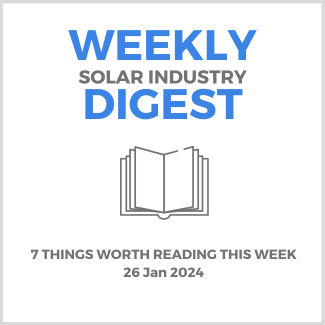SPW looks at the issue of safety for contractors working on roofs in the commercial market sector. They talk about the unique hazards and the inherent risks of these projects and discuss the different layers of safety considerations and equipment to take into account.
GreenBiz dives into how Wall Street views transition finance these days – particularly for investors. Defined as investments meant to decarbonize high-emitting and hard-to-abate industries that also address potential social impacts associated with decarbonization, GreenBiz characterizes it as a multi-trillion-dollar opportunity. They look at private capital and public-private partnerships.
Solar optimizer manufacturer, Enteligent, is transitioning its production facilities to America as it seeks to fully capitalize on the IRA’s $0.11/W transferable tax credit and enhance the offerings for their inverter partners. This is a move that is aligned with industry developments, like First Solar’s recent sale of $700 million in tax credits to fund its solar panel manufacturing operations in the U.S.
SPA argues that the installed capacity of energy storage in the community and C&I markets is woefully underdeveloped, especially compared to what it could be. They talk about the largest growth area (CA) and look at the role of supportive policies in a number of states. They also point to the need for manufacturers to make the value clearer.
Researchers have uncovered a new method to increase solar cell efficiency by a factor of 1,000 by creating crystalline layers of barium titanate, strontium titanate, and calcium titanate, which were alternately placed on top of one another in a lattice structure. Apparently, combining extremely thin layers of different materials significantly increases solar energy yield.
Solar Builder looks at how manufacturers might sidestep AD/CVD tariffs. They discuss manufacturing cells and modules in SE Asia using wafers from countries other than China OR using Chinese wafers but with sufficient non-Chinese input materials. Additionally, they look at manufacturing modules in a third country using SE Asian cells that employ Chinese wafers and manufacturing cells and modules (and, optionally, wafers) in America.
In this Solar Conversation, Kerim Baran of SolarAcademy talks with Justin Redd, Head of Sales and Marketing at Emmvee. In this conversation, Kerim & Justin talk about:
- Justin’s journey in the solar industry, from working on solar installation programs at the Tennessee Solar Institute and his first sales role at Sharp, to being part of Emmvee’s entry into the US solar market.
- Emmvee’s history and growth in the Indian Market, establishing its first 15-MW fully automated PV module line of India back in 2006 (currently a 750 MW line), and growing into a business with 3GW of solar manufacturing capacity and over 1 billion dollars in assets.
- Emmvee’s US go-to-market strategy, the key customers they’re serving, and how Emmvee addresses some of the concerns around Indian manufacturing to evoke confidence and conduct business in the highly competitive US market.
The video is below.

